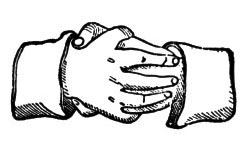a lot of people take masonic is a secrets society. do you get some idea of its handshakes?
A handshake is defined as the act of grasping and shaking a person’s hand (as to acknowledge an introduction or to agree on a contract). The Masonic Handshake is an important symbol used to represent members of the society of freemasons. There are several different handshakes depending on the level of the mason. The act of shaking a masons hand will indicate immediately what level a mason is, without a single spoken word! Masonic handshakes are mainly used for social purposes as a form of recognition.
Masonic Handshake – Masters Grip

The Master’s grip is shown in the image on the right. It is given by taking hold of the other person’s hand as if you were going to shake hands, then place the nails of each of your fingers into the joint of the other person’s wrist where it unites with the hand. If the person whom you are shaking hands with is a Mason, he will generally return a like pressure on your hand.
Masonic Handshake – Pass Grip of Master Mason

The pass-grip of a master mason is shown in the image on the right. It is given by taking hold of the other’s hands as in ordinary handshaking and pressing the top of the thumb hard against the space between the second and third knuckles. If the person whom you are shaking hands with is a Mason, he will generally return a like pressure on your hand.
Masonic Handshake – Real Grip of Fellow Craft

The real grip of a fellow craft is shown in the image on the right and given by taking each other by the right hand as in ordinary hand-shaking and pressing the top of your thumb hard against the second knuckle. If the person whom you are shaking hands with is a Mason, he will generally return a like pressure on your hand.
Masonic Handshake – Pass Grip of Fellow Craft


The pass-grip of fellow craft is shown in the image on the right and given by taking the other’s hands as in ordinary hand-shaking and pressing the top of the thumb hard against the space between the first and second knuckles of the right hand. If the person whose hand you hold is a Fellow Craft, he will return a like pressure on your hand or may give you the grip of an Entered Apprentice.
Masonic Handshake – Grip of Entered Apprentice
The grip of an entered apprentice is shown in the image on the right and given by taking hold of each other’s hands as in ordinary hand-shaking and pressing the top of the thumb hard against the first knuckle-joint of the first finger near the hand. If the person whom you are shaking hands with is a Mason, he will generally return a like pressure on your hand.
10 facts about the masonic handshake
Masonic Handshake Fact 1: The Master’s grip is given by taking hold of the other person’s hand as if you were going to shake hands, then place the nails of each of your fingers into the joint of the other person’s wrist where it unites with the hand
Masonic Handshake Fact 2: The five points of masonic fellowship are: foot to foot, knee to knee, breast to breast, hand to back and either mouth to ear or cheek to cheek
Masonic Handshake Fact 3: The real grip of a fellow craft is described as follows: “Take each other by the right hand as in ordinary hand-shaking and press top of your thumb hard against the second knuckle”
Masonic Handshake Fact 4: The pass-grip of a master mason is described as follows: “Take hold of each other’s hands as in ordinary handshaking and press the top of your thumb hard against the space between the second and third knuckles”
Masonic Handshake Fact 5: The strong grip of a master mason is described as follows: “Grasp each other’s right hands very firmly, the spaces between the thumb and first finger being interlocked and the tops of the fingers being pressed hard against each other’s wrist where it joins the hand, the fingers of each being somewhat spread”
Masonic Handshake Fact 6: The masons pass-grip is given by pressing the thumb between the joints of the second and third fingers where they join the hand
Masonic Handshake Fact 7: Often the word ‘token’ is used to describe the sign or grip given by masons as brotherly recognition
Masonic Handshake Fact 8: In freemasonry, the hand is a symbol of human actions. Pure hands are symbolic of pure actions whilst unclean hands are symbolic of impure actions
Masonic Handshake Fact 9: Masonic handshakes are mainly used for social purposes as a form of recognition
Masonic Handshake Fact 10: The symbolic meaning of a masonic handshake can be described as follows: “This physical act is the outward sign, or token, of the union of our minds and hearts.”
source: signology.org








